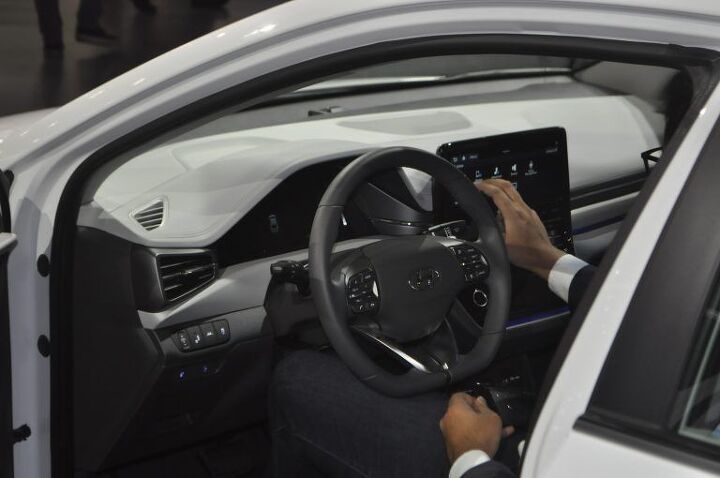2020 Hyundai Ioniq: Modest Changes, but the Electric Goes to War With Nissan

No one wants to come in last. With the Volkswagen e-Golf and Smart Fortwo EQ Electric Drive Whatever discontinued, Hyundai’s compact Ioniq Electric hatchback was poised to be the lowest-range electric vehicle in the North American market (minus, of course, the limited-availability, lease-only Honda Clarity EV).
Clearly, this looming position at the bottom of the ladder left a bad taste in Hyundai’s mouth. Preferring to see Nissan there, it set about making the necessary changes.
For 2020, the Ionic line, which encompasses a very thrifty hybrid, a plug-in hybrid, and an EV, undergoes some mild styling changes and adds the Hyundai SmartSense suite of safety features as standard equipment. There’s a revised grille and fascia (non-electrics get mesh), plus LED lamps fore and aft on uplevel trims, side sill moldings, and revamped wheel designs.
But you’re probably wondering how the Ioniq Electric, a low-priced green vehicle unlikely to grace the driveway of any TTAC reader, kicks Nissan’s ass. Well, for 2020 the model swaps its petite 28 kWh battery pack for a beefier 38.3 kWh unit. The swap elevates the vehicle’s driving range from a mediocre-at-best 124 miles to 170 miles, outclassing the base Nissan Leaf’s 151-mile range.
Unlike the Leaf, however, Ioniq buyers can’t shell out extra cash for a 226-mile “Plus” variant. Oh well. At least Hyundai can boast of its base EV offering more range. While Hyundai didn’t mention Ioniq Electric pricing, the 2019 model started at $31,245 after destination and before a $7,500 federal tax credit. That’s $330 more than a base Leaf S.
For the coming model year, the Electric also offers more grunt: 134 horsepower, compared to the previous 118 hp, though torque remains the same at 218 lb-ft. Charging speed also rises, from 6.6 kW to 7.2 kW, promising quicker battery top-ups. As for the Hybrid and PHEV, their powertrains remain unchanged.
Inside all Ioniqs, the newly upgraded 8-inch touchscreen (2019MY had a 7-inch) can be binned in favor of a 10.25-inch “widescreen” with navigation (see below), while the instrument panel also undergoes a revision. A new center LCD information screen joins the fray, as do touchscreen HVAC controls. Ambient lighting is customizable.
Hybrid buyers finally get the regenerative braking control paddles that eluded them up to this point.
As for safety, the SmartSense features include forward collision avoidance, lane-keeping assist, high beam assist, and driver attention warning. If road trips make you nervous, highway driving assist and lane following assist are optional.
Arriving in early 2017, the electrified Ioniq line hasn’t exactly set the sales charts on fire, though the past few months has seen the model’s volume increase noticeably. Year to date, Ioniq sales are up 33 percent.
[Images: Hyundai, Tim Healey/TTAC]

More by Steph Willems
Latest Car Reviews
Read moreLatest Product Reviews
Read moreRecent Comments
- ToolGuy I have 2 podcasts to listen to before commenting, stop rushing my homework.
- ToolGuy Please allow me to listen to the podcast before commenting. (This is the way my mind works, please forgive me.)
- ToolGuy My ancient sedan (19 years lol) matches the turbo Mazda 0-60 (on paper) while delivering better highway fuel economy, so let's just say I don't see a compelling reason to 'upgrade' and by the way HOW HAVE ICE POWERTRAIN ENGINEERS BEEN SPENDING THEIR TIME never mind I think I know. 😉
- FreedMike This was the Official Affluent-Mom Character Mobile in just about every TV show and movie in the Aughts.
- Offbeat Oddity The RAV4, and I say this as someone who currently owns a 2014 CR-V. My aunt has a 2018 CR-V that has had a lot of electrical issues, and I don't trust the turbo and CVT to last as long as Toyota's NA engine and 8-speed automatic. Plus, the RAV4 looks sportier and doesn't have the huge front overhang.





































Comments
Join the conversation
"...a low-priced green vehicle unlikely to grace the driveway of any TTAC reader" I have one (in blue, a 2019), and I don't even live in a CARB state. In the past year I've driven it 14k trouble-free miles. The first maintenance expense was a set of wipers this week. It's added maybe $30 to my electric bill each month. Range has been fine, with anxiety only a couple times when I know I've been pushing it. This car is way better than my 12 Leaf was, and IMO, when I test drove an 18 Leaf it felt just like a warmed-over version of my old car. Hyundai has a hidden gem in the Ioniq, but they don't seem committed to expanding its market.
Proposed interim new-car buying advice based on this article: "Wait two years if you can." Rationale: EV's are likely to improve, and charging infrastructure may improve. Many ICE powertrains will continue down the path of voluntary seppuku. Both EV and ICE will have the opportunity to iron out safety, driver assistance and touchscreen issues.